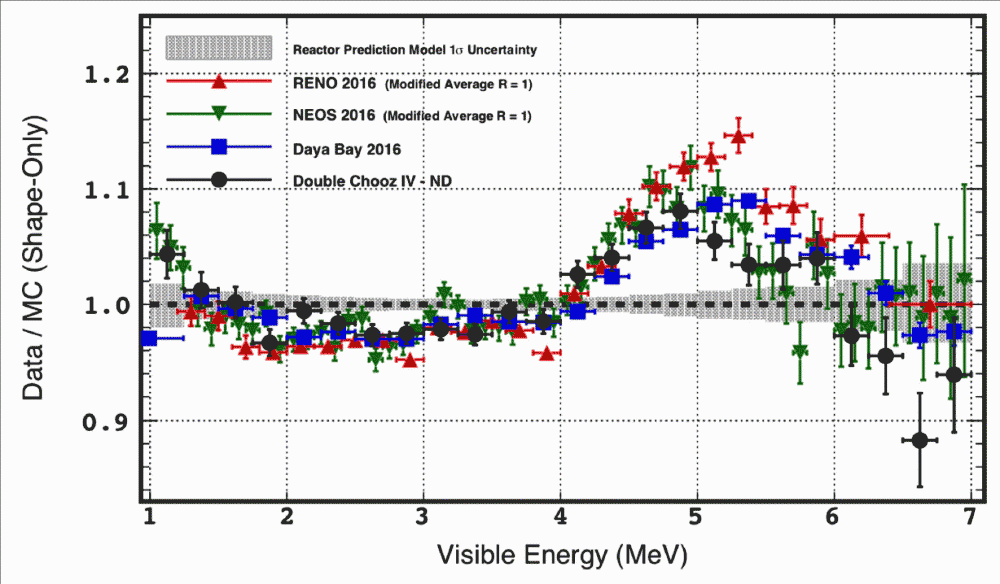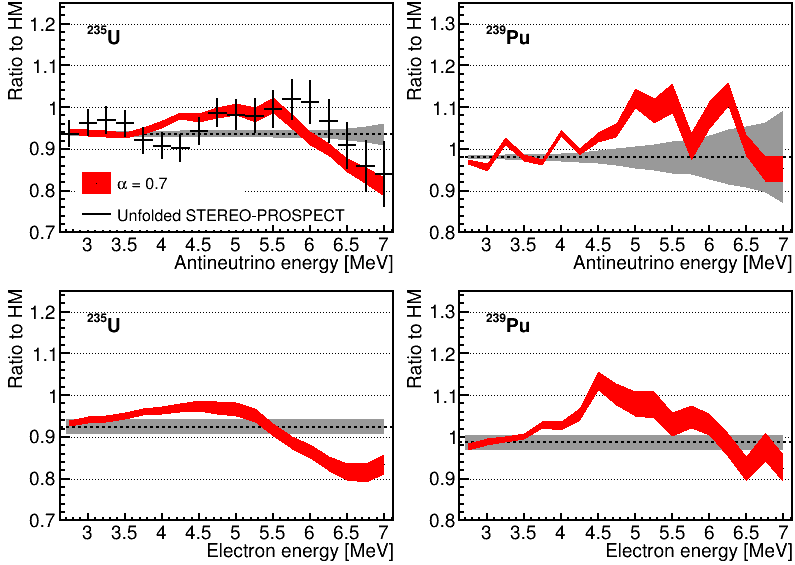
Figure 1. deviations between measurements and predictions (by simulation) observed in the antineutrino energy spectra measured by the four most recent high-precision experiments at commercial reactors compared to the Huber-Mueller prediction [3].
Reactor antineutrino anomalies are a decade-long puzzle in neutrino physics. They are manifested by deviations of the order of a few percent between measurements and predictions. These deviations have been observed in the number of antineutrinos measured by more than a dozen experiments at nuclear reactors, and in the shape of the kinetic energy distributions by the seven most recent ones. They could have been the way to a new physics beyond the standard model, but the recent experiments, including the STEREO experiment carried by IRFU, have closed this door.
In a work just published in Physical Review Letter [1], a team of physicists from IRFU and the Laboratoire National Henri Becquerel of DRT have shown that these anomalies could come from biases in the measurements of fission electrons used as a reference for the prediction. They have developed a beta strength function model to reduce the biases in the calculation of the energy spectra of electrons from fission of fissile reactor nuclei. The two "anomalies" on the antineutrino flux and the "bump" at 5 MeV in the antineutrino energy spectrum are now reproduced by their model. This allows to propose an explanation to solve an enigma of more than 10 years.
Reactor antineutrinos
Nuclear reactors are very intense sources of electron antineutrinos. These are produced during the beta decay of fission products. For each decay, an electron and an electron antineutrino are emitted. While the electron is trapped in the reactor and contributes to its heating, the antineutrino escapes. Nuclear reactors are therefore used as sources for dedicated experiments to constrain the neutrino oscillation parameters or to search for physics beyond the standard model. In this respect, IRFU has made a major contribution to two major experiments in this field: Double-Chooz, installed at the Chooz nuclear power plant, and STEREO, installed at the high-flux reactor of the Institut Laue Langevin in Grenoble.
The two reactor antineutrino anomalies
- The first one was highlighted by the IRFU team [2], more than ten years ago, and shows a discrepancy of about 6% between the number of measured antineutrinos and the one predicted. The detectors were then placed at less than 100 m from the nuclear power plants.
- The second appeared in recent high precision experiments - including Double-Chooz - by measuring not only the number of antineutrinos, but also their energy spectrum. The measurements show an excess of events around an energy of 5 MeV compared to the prediction [3] (see Figure 1).
These anomalies have aroused a lot of interest in the neutrino physics community because like any anomaly they can be the object of new discoveries. It is indeed through an anomaly (the solar neutrino deficit) that the existence of oscillations and therefore of a mass for the neutrino has been discovered.
In this vein, the reactor neutrino anomalies could be the consequence of the existence of a sterile low mass state of the neutrino. This hypothesis has generated a lot of work both experimentally and theoretically around the world. Several experiments, including the STEREO experiment carried by IRFU, have been carried out to try to validate or invalidate this hypothesis. The most recent results show that this hypothesis can be rejected with a very high confidence.
The prediction
The question of prediction and its reliability arises. This is based on a conversion of the kinetic energy spectra of the fission electrons to those of the antineutrinos. The energies of the electrons were measured in the 1980s in the high flux reactor of the Institut Laue Langevin in Grenoble using the high resolution magnetic spectrometer BILL. Fissile element targets were plunged into the reactor core, and the electrons emitted during fission were measured by the spectrometer located outside, more than ten meters away. Using this device, the fission electrons of 235U, 239Pu and 241Pu were measured. At present, these are the only measurements with such precision that exist and serve as references.
The conversion method is based on the fact that the electrons and antineutrinos emitted during a beta transition share the energy of the transition. It is then possible to convert a spectrum in electron energy into a spectrum in antineutrino energy. This method is accurate in the sense that it propagates only the uncertainty of the measured electron spectrum. However, if there are experimental biases in this measurement, these biases will be propagated into the antineutrino spectra by the method.

Figure 2: Illustration of the electron kinetic energy distributions obtained by BESTIOLE for the beta decay of 90Br using our model (in blue) or the decay data from the ENSDF nuclear database (in red). The simulation is compared, for three values of the single parameter of the alpha model, to a measurement made by Rudstam et al. (in magenta).
The beta strength function model
In order to test this hypothesis, we used another approach, known as summation, to calculate the energy spectra of fission antineutrinos. We used the BESTIOLE code developed and recently updated at IRFU [4]. This approach consists in calculating the kinetic energy distribution of electrons and antineutrinos at the level of a beta transition. Then we sum these distributions over all the beta transitions that take place in a nuclear reactor. This operation requires the treatment of a large number of nuclei produced by the fission process, some of which are very far from the stability valley and rich in neutrons, and therefore little known. The associated nuclear data are sometimes fragmentary and/or biased.
To overcome this problem, we have developed [5] a beta strength function model capable of constructing the missing transitions in nuclear databases and thus covering all transitions of all fission products. The beta strength function is a quantity that contains the matrix element of the transition and that allows to calculate the probability of feeding an excited level in the daughter nucleus. It is a phenomenological model based on a statistical analysis of Gamow-Teller resonances measured by calorimetry. In these calorimetry experiments, the total energy of the gamma rays emitted during the beta decay is recorded, which allows to trace the settlement of each level in the child nucleus. The model has only one free parameter α common to all nuclei. As illustrated in Figure 2, this single parameter model reproduces individual beta spectra quite well where databases are at fault. By this approach, we can generate electron and antineutrino spectra in the same formalism and with the same ingredients and thus test the compatibility of the experimental spectra.
It appears that with this simplified approach, we are able to reproduce the antineutrino spectrum measured by the STEREO and PROSPECT experiments [6], and to reproduce the observed deviations from the prediction on the antineutrino side (figure 3). The same deviations are found on the electron side. We deduced an incompatibility between the measured antineutrino spectra and the measured electron spectra which were used as reference for the prediction. This observation highlights possible experimental biases in the fission electron spectra measured at ILL that could be at the origin of the reactor antineutrino anomalies.
Figure 3: Ratio of the kinetic energies calculated by our model (in red), for a value of ? that best reproduces the measurements, to those calculated by the Huber-Mueller prediction for fission antineutrinos (top) and for fission electrons (bottom). The result of the combined measurement of STEREO and PROSPECT [5] is also given. These ratios are given for the two majority fissile nuclei in a commercial nuclear reactor.
The grey bands correspond to the systematic uncertainties related to the fission yields (for the two top figures) and to the ILL measurements (for the two bottom figures)

Importance and implications
This result brings a new light to the problem of reactor antineutrino anomalies. It is the only work that allows to treat the two observed anomalies in a consistent approach and to identify a possible common origin.
Moreover, the beta strength function model developed in this work is an essential ingredient in the modeling of beta decay. The applications of this model are diverse, whether for future antineutrino experiments at reactors, or for the calculation of residual heating in nuclear reactors or in nuclear waste packages. It also allows, for example, to predict the doses deposited in cells during radiotherapy treatments. This original work is the result of a collaboration between DRF and DRT within the framework of the PTC (Transverse Competence Project) NeNuPHAR simulation. The development of the model will continue to improve its accuracy and predictability.
Contact Irfu: Alain Letourneau
References
[2] G. Mention, M. Fechner, T. Lasserre, T.A. Mueller, D. Lhuillier, M. Cribier, A. Letourneau, Phys.Rev. D 83, 073006 (2011).
[3] H. de Kerret et al. (Double Chooz Collaboration), Nat. Phys. 16, 558 (2019).
[4] L. Perissé, thèse de doctorat, "Modeling of reactor antineutrino spectra", Université Paris-Saclay (2021), https://tel.archives-ouvertes.fr/tel-03538198.
[5] V. Savu, thèse de doctorat, "Reactor neutrino studies: STEREO and NUCLEUS experiments", Université Paris-Saclay (2021), https://tel.archives-ouvertes.fr/tel-03563659.
[6] H. Almazán et al. (PROSPECT Collaboration, STEREO Collaboration), Phys. Rev. Lett. 128, 081802 (2022).
• Structure of nuclear matter › Nuclear reaction dynamics The ultimate constituents of matter › Neutrino Physics
• The Nuclear Physics Division • The Particle Physics Division
• LEARN - Study and Applications of Nuclear Reactions • Sources and reactors neutrinos

